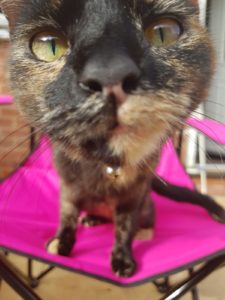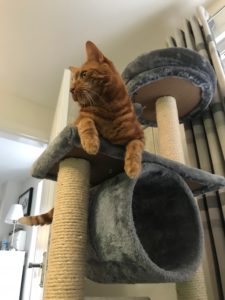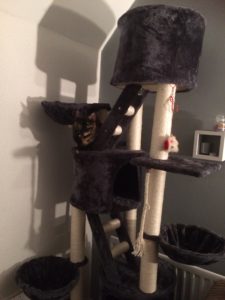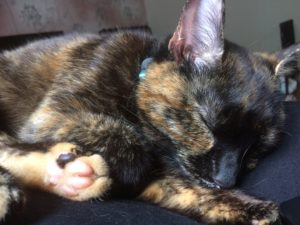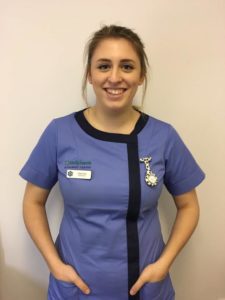 As a registered nurse I am here to help animals have the best experience possible whilst visiting us in practice. When animals are scared and don’t want us to examine them, it can be distressing for everyone involved and makes our job of trying to help them very difficult. Owners can then be reluctant to bring their pets in which leads to a delay in the detection of any disease. With this in mind, I have developed my desensitising clinics to help change their experiences and the way they view us from negative to positive.
As a registered nurse I am here to help animals have the best experience possible whilst visiting us in practice. When animals are scared and don’t want us to examine them, it can be distressing for everyone involved and makes our job of trying to help them very difficult. Owners can then be reluctant to bring their pets in which leads to a delay in the detection of any disease. With this in mind, I have developed my desensitising clinics to help change their experiences and the way they view us from negative to positive.
In the clinics I work at the patient’s pace and don’t force them to do anything. Dogs learn quicker if they choose to do something rather than being lured. I also monitor their behavioural responses and body language for subtle changes that let me know how they aren’t happy with what I am doing (appeasement signals). These subtle signals can include:
- yawning
- lip licking
- ‘whale eye’ (showing a crescent shape white of their eye)
- turning their head away
- staying close to their owners
- lack of focus
- sweaty paws
I usual ask the owners to bring in a high value reward, something they wouldn’t normally have, usual canned hotdog sausage or some grated cheese. This is used initially as rewards for just being in the room, encouraging them to see us in a positive way before any handling starts.
Once they are happy coming to the practice high value rewards are then used to help train their body parts (a handout can be provided on this for the owners to perform at home). By learning their body parts, it helps to reduce any anxiety they are feeling as they know which part of the body is going to be touched. It also puts a positive association on being handled. The areas I generally train are:
- left and right ear
- left and right fore
- left and right hind
- scruff
- ‘listen’ – the stethoscope is placed on the chest
The next stage is to get them used to the equipment that may be used on them in a consult room e.g. stethoscope, needle and syringe, auroscope (used to look down their ears), clippers for claw trimming. Each session is designed specifically for the individual.
Occasionally when patients are too nervous it can impair their ability to learn and so I would generally then broch the topic of providing nutraceutical support (a dietary supplement). Most nutraceuticals used for anxiety contain amino acids such as L- Tryptophan and L-theanine that stimulate the production of serotonin. Serotonin plays an important role in maintaining calm and relaxation in animals. Deficiency in some B vitamins has been associated with nervous and anxiety disorders, so some products may also contain these. By reducing their nervousness/anxiety it increases their ability to learn optimising the behavioural therapy program.
It is important to think about all aspects when performing desensitising clinics and this includes the clothes we wear. Through classical conditioning animals learn to make associations with the uniforms that we have so when performing desensitisation it is important to wear different clothing to help reduce their anxiety. These scrub tops offer a different style and colour to the uniform they are used to seeing.
We also have special matts that the dogs can lick food off. These can be used for dogs that are particularly anxious. These mats work two- fold; licking is a de-stressing activity for them but it also offers a chance to change their negative emotional state to a positive state by using food in a non conflicting way. For example, when we offer food by hand, they want the food but don’t want to come close to get it which is conflicting and confusing for them.
Patients usually come every week initially and once I am happy they are happy with what is being asked of them the time between session is lengthened. They will always need to attend desensitising sessions as they can resort back to previous behaviours if they start to see us as a negative experience again. Hopefully the sessions will be limited in number throughout the year.
Meet Sox
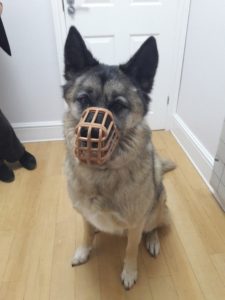 Sox is one of the first desensitising patients to come to see me. He didn’t like coming to the vets and certainly didn’t like having to put a muzzle on. Over the weeks Sox has been coming he has learnt to except a muzzle through games and training with the use of positive reinforcement. He will now allow us to handle his scruff and give ‘mock’ injections and he will also let us listen to his heart. He is very clever and an absolute super star.
Sox is one of the first desensitising patients to come to see me. He didn’t like coming to the vets and certainly didn’t like having to put a muzzle on. Over the weeks Sox has been coming he has learnt to except a muzzle through games and training with the use of positive reinforcement. He will now allow us to handle his scruff and give ‘mock’ injections and he will also let us listen to his heart. He is very clever and an absolute super star.
Brave boy!
Sox recently had a torn claw which needed to be removed. Having a torn claw is a bit like when we snag a nail and it tears onto the nail bed. It is very sore and often bleeds but it does need to be removed. Sox allowed the vet to put the muzzle on and even gave his sore paw when asked for it. The nail was removed and he had lots of nice treats afterwards! Well done Sox!
If you would like to know more about desensitisation clinics with Natalie then please phone us on 01606 880890.


